Successful advocacy campaigns are built on strategic approaches that effectively engage communities and communicate impactful messages. By leveraging data-driven storytelling and coalition building, these campaigns can measure their outcomes through various metrics and feedback, providing valuable insights for future efforts. Key lessons learned emphasize the importance of clear messaging and sustained stakeholder engagement to drive meaningful change.
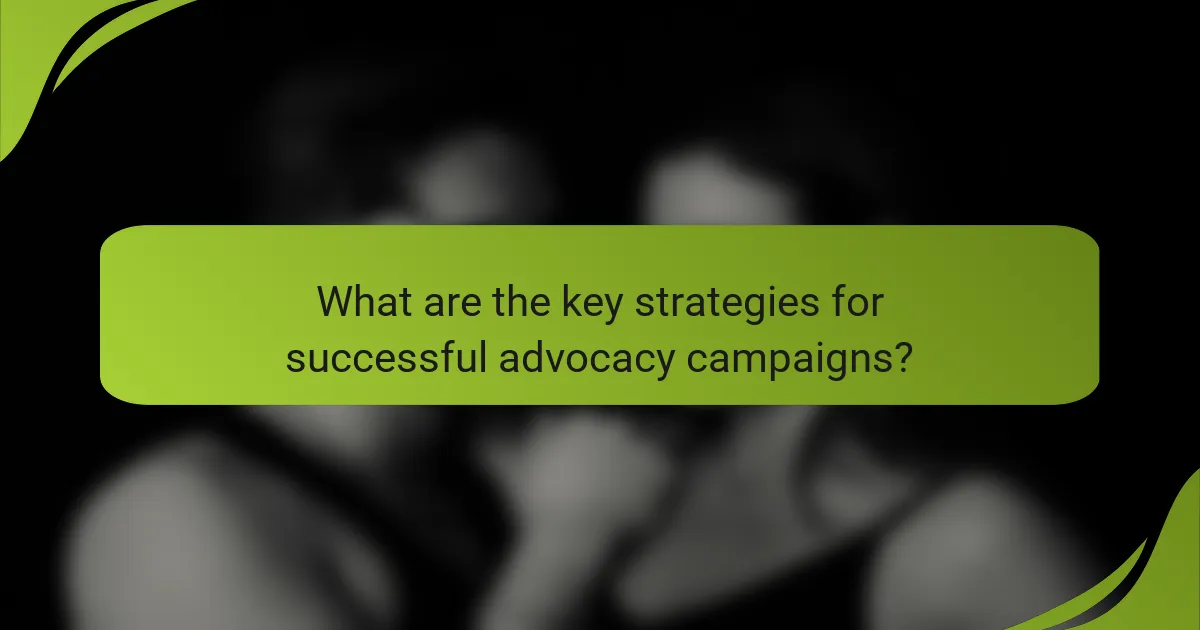
What are the key strategies for successful advocacy campaigns?
Successful advocacy campaigns rely on a combination of strategic approaches that engage communities, utilize data, and effectively communicate messages. Key strategies include community engagement, data-driven storytelling, coalition building, targeted messaging, and leveraging social media.
Community engagement
Community engagement is crucial for building trust and support for advocacy efforts. Involving local stakeholders ensures that the campaign resonates with the audience and addresses their specific needs. Consider hosting town hall meetings or workshops to gather input and foster collaboration.
Effective community engagement can lead to increased participation and advocacy from local residents. Utilize surveys or feedback forms to assess community priorities and adapt your strategies accordingly.
Data-driven storytelling
Data-driven storytelling combines compelling narratives with relevant statistics to strengthen advocacy messages. This approach helps illustrate the impact of issues and can persuade decision-makers by providing concrete evidence. Use data visualizations, such as infographics, to make complex information more accessible.
When crafting stories, focus on local data that reflects the community’s experiences. For instance, if advocating for environmental changes, include statistics on local pollution levels and their effects on public health.
Coalition building
Building coalitions with like-minded organizations amplifies advocacy efforts and broadens the reach of campaigns. Collaborating with diverse groups can bring additional resources, expertise, and credibility to your cause. Identify potential partners who share similar goals and values.
Effective coalitions require clear communication and shared objectives. Establish regular meetings to align strategies and ensure all members are engaged and informed about campaign progress.
Targeted messaging
Targeted messaging tailors communication to specific audiences, enhancing the likelihood of engagement and action. Understand the demographics, interests, and concerns of your target groups to craft messages that resonate. Use language and examples that reflect their experiences and values.
Consider segmenting your audience and developing customized messages for each group. For example, messages aimed at policymakers may focus on legislative impacts, while those for the general public might emphasize personal stories and community benefits.
Utilizing social media
Social media is a powerful tool for advocacy campaigns, allowing for rapid dissemination of information and engagement with a broad audience. Platforms like Facebook, Twitter, and Instagram can be used to share updates, mobilize supporters, and create a sense of community around the cause.
To maximize impact, develop a social media strategy that includes regular posts, interactive content, and calls to action. Monitor engagement metrics to refine your approach and ensure that your messaging remains relevant and effective.
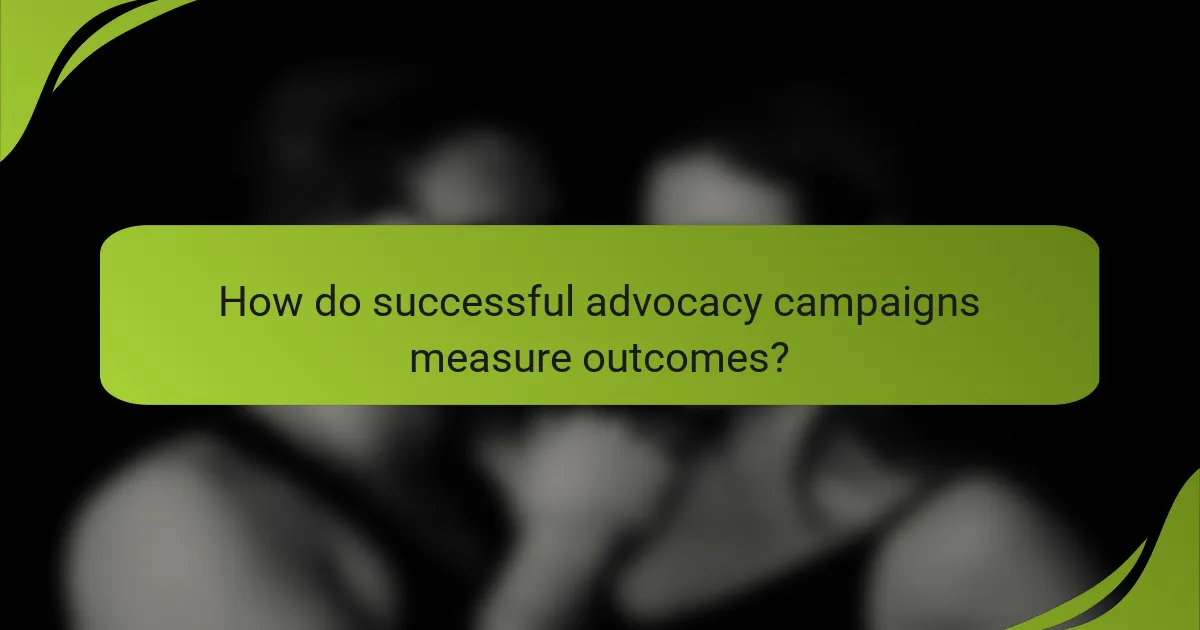
How do successful advocacy campaigns measure outcomes?
Successful advocacy campaigns measure outcomes through a combination of quantitative metrics, qualitative feedback, and media coverage analysis. These methods provide a comprehensive view of the campaign’s effectiveness and impact on the target audience and stakeholders.
Quantitative metrics
Quantitative metrics involve numerical data that can be tracked and analyzed to assess a campaign’s success. Common metrics include the number of petitions signed, funds raised, or social media shares. For instance, a campaign might aim for a specific percentage increase in supporters or donations within a set timeframe.
When establishing quantitative goals, it’s crucial to set realistic and measurable targets. For example, aiming for a 20% increase in engagement over three months can provide a clear benchmark for success. Regularly reviewing these metrics helps in adjusting strategies as needed.
Qualitative feedback
Qualitative feedback focuses on the opinions and experiences of individuals impacted by the campaign. This can be gathered through surveys, interviews, or focus groups, providing deeper insights into the campaign’s effectiveness. Understanding personal stories can highlight the emotional resonance of the advocacy efforts.
To effectively collect qualitative feedback, consider using open-ended questions that allow respondents to express their views freely. Analyzing this feedback can reveal strengths and weaknesses in the campaign, guiding future initiatives. For example, if participants express confusion about the campaign’s message, it may indicate a need for clearer communication.
Media coverage analysis
Media coverage analysis examines how the campaign is represented in news outlets and social media. This includes tracking the number of articles published, the tone of the coverage, and the reach of the messages conveyed. Positive media coverage can significantly enhance a campaign’s visibility and credibility.
To conduct a thorough media analysis, utilize tools that monitor mentions across various platforms. Assessing the sentiment of the coverage can help identify public perception and areas for improvement. For instance, if coverage is predominantly negative, it may necessitate a reevaluation of messaging or strategy to better align with public sentiment.
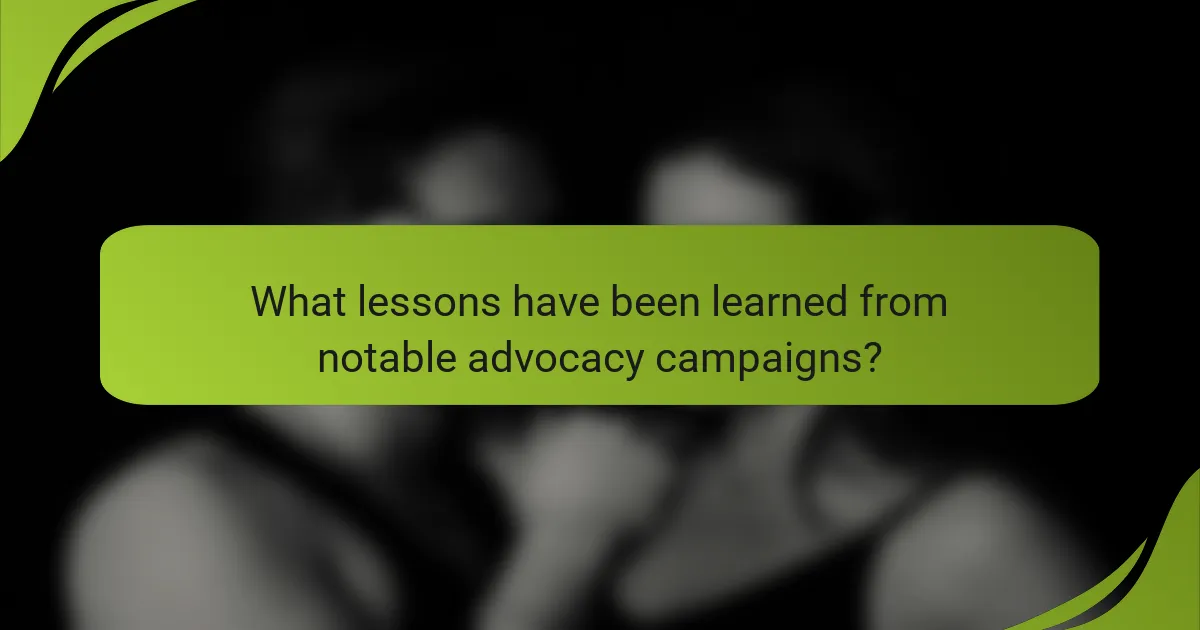
What lessons have been learned from notable advocacy campaigns?
Notable advocacy campaigns have revealed key strategies and outcomes that can guide future efforts. Successful campaigns often emphasize clear messaging, coalition-building, and sustained engagement with stakeholders.
Case study: Marriage Equality USA
The Marriage Equality USA campaign showcased the power of grassroots mobilization and strategic litigation. By building coalitions with various organizations and leveraging social media, advocates effectively raised awareness and support for marriage rights across the United States.
A critical lesson from this campaign is the importance of framing the issue in relatable terms. Advocates focused on personal stories and the fundamental right to love, which resonated with a broad audience. This approach helped shift public opinion significantly over time.
Case study: Climate Action Network
The Climate Action Network illustrates the effectiveness of international collaboration in advocacy. By uniting diverse organizations under a common goal, the network has successfully influenced global climate policies and agreements, such as the Paris Agreement.
Key takeaways from this campaign include the necessity of clear, actionable goals and the use of scientific data to support arguments. Engaging local communities and emphasizing the immediate impacts of climate change can also enhance public engagement and drive policy changes.

What are the prerequisites for launching an advocacy campaign?
Launching a successful advocacy campaign requires thorough preparation, including understanding the context, identifying stakeholders, and securing resources. These prerequisites set the foundation for effective messaging and outreach.
Understanding the target audience
Identifying and understanding your target audience is crucial for an advocacy campaign. This involves researching demographics, interests, and behaviors to tailor your message effectively. Consider segmenting your audience into groups based on their influence, needs, and potential support for your cause.
Utilize surveys, focus groups, or social media analytics to gather insights about your audience. For example, if advocating for environmental policy, target groups may include local residents, business owners, and policymakers, each requiring a different approach.
Defining clear objectives
Clear objectives provide direction and measurable outcomes for your advocacy campaign. Start by defining what you want to achieve, whether it’s raising awareness, influencing legislation, or mobilizing community support. Use the SMART criteria—Specific, Measurable, Achievable, Relevant, Time-bound—to formulate these objectives.
For instance, instead of a vague goal like “increase awareness,” aim for “increase social media engagement by 30% within three months.” This clarity helps in strategizing your efforts and evaluating success throughout the campaign.
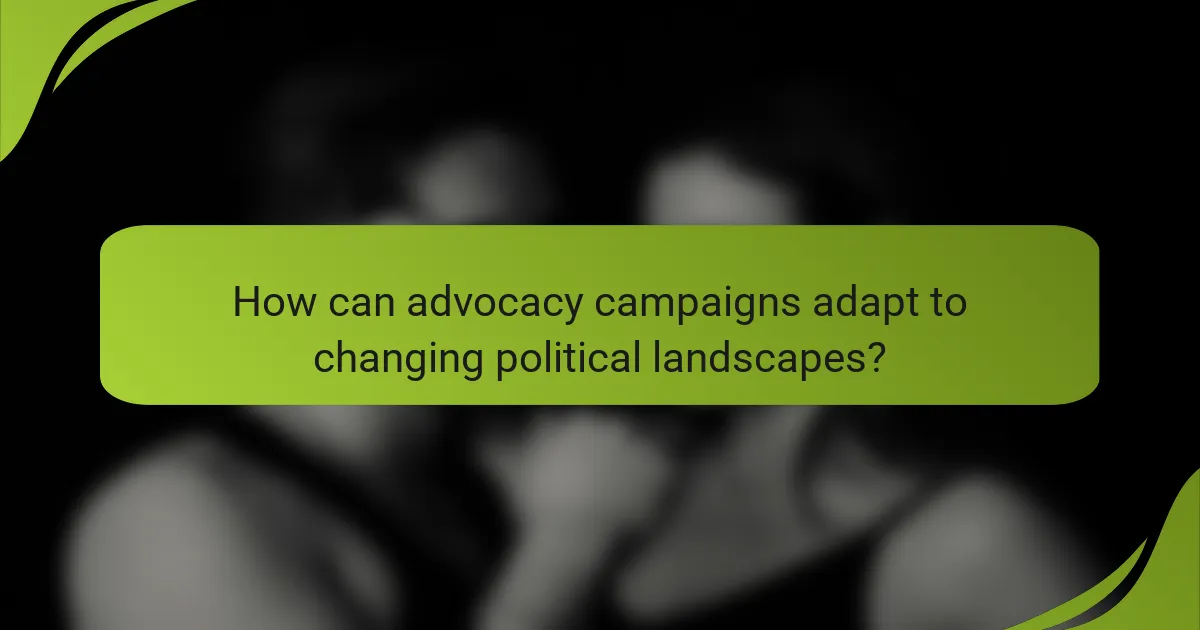
How can advocacy campaigns adapt to changing political landscapes?
Advocacy campaigns must remain agile to effectively respond to shifting political climates. This involves adjusting strategies and messaging to align with current events, public sentiment, and policy changes.
Flexibility in messaging
Successful advocacy campaigns prioritize flexibility in their messaging to resonate with diverse audiences. This means being prepared to pivot communication strategies based on emerging issues or public reactions. For instance, if a new policy proposal gains traction, campaigns should quickly incorporate relevant talking points into their outreach efforts.
To maintain this flexibility, organizations can develop a core message framework that allows for easy adaptation. This framework should include key themes and values that can be tailored to specific contexts or audiences, ensuring consistency while allowing for responsiveness.
Real-time data analysis
Utilizing real-time data analysis is crucial for advocacy campaigns to stay relevant and effective. By monitoring social media trends, public opinion polls, and legislative developments, campaigns can quickly identify shifts in the political landscape and adjust their strategies accordingly.
Implementing tools for data collection and analysis can enhance responsiveness. For example, using social listening platforms can help organizations gauge public sentiment and identify emerging issues, enabling them to craft timely and impactful messages. Regularly reviewing this data ensures that campaigns remain aligned with current political dynamics.
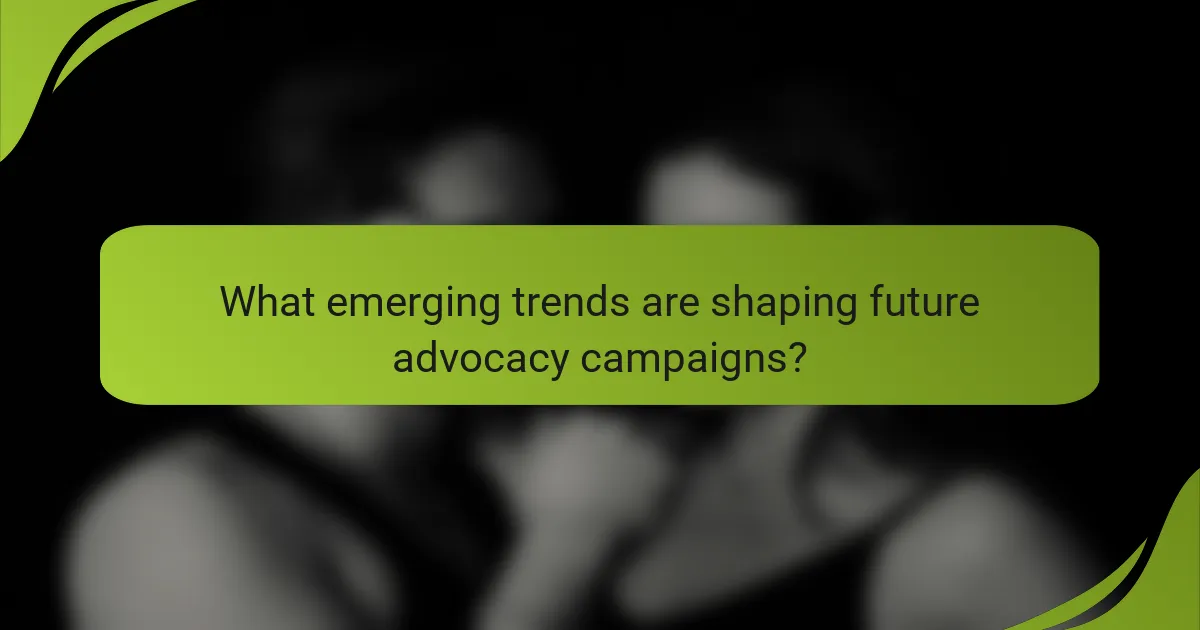
What emerging trends are shaping future advocacy campaigns?
Future advocacy campaigns are increasingly influenced by technological advancements, shifting public engagement strategies, and a focus on data-driven decision-making. These trends are reshaping how organizations connect with their audiences and measure their impact.
Increased use of technology
The integration of technology in advocacy campaigns is transforming communication and outreach methods. Tools like social media platforms, mobile apps, and data analytics are enabling advocates to reach larger audiences more effectively and efficiently.
For instance, organizations can use social media to mobilize supporters quickly, share information in real-time, and create viral campaigns. Additionally, data analytics can help track engagement metrics, allowing for adjustments to strategies based on what resonates with the audience.
When implementing technology, it’s crucial to ensure that the tools align with the campaign’s goals. Avoid over-reliance on any single platform; instead, diversify your outreach to include various channels to maximize impact and reach different demographics.


